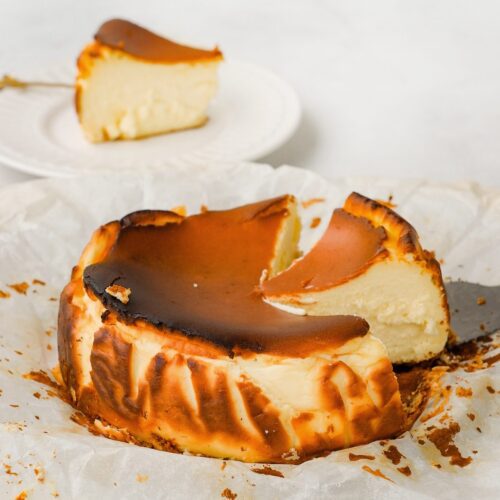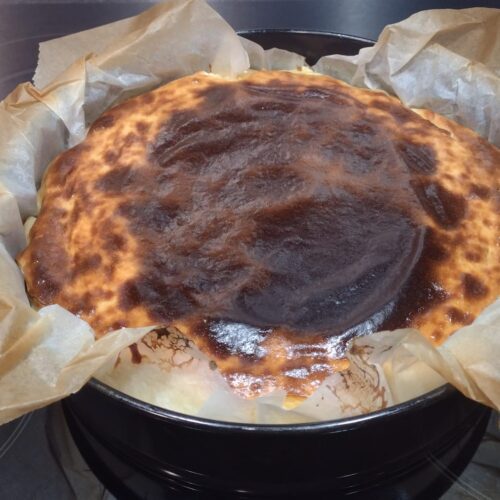Last updated on 30-Aug-2024
The Basque cheesecake, also known as Burnt Basque cheesecake, is a type of cheesecake that originated in the Basque Country of northern Spain, where it’s simply called Tarta de Queso. It is characterized by its burnt, caramelized exterior and a smooth, custardy interior that is rich, decadent, and almost mousse-like. It also differs from some other types of cheesecake because it has no crust.
There are many other types of cheesecake, each with its own unique flavour and texture. Here are some of the most popular types:
- New York-style cheesecake: classic cheesecake made with cream cheese, eggs, and sugar, and has a dense, creamy texture added to a buttery crust.
(Check out my recipe with a tropical twist)- Italian-style cheesecake: made with ricotta cheese instead of cream cheese, which gives it a lighter texture and a slightly tangy flavour.
- French-style cheesecake: lighter and less sweet than the New York-style cheesecake, and is often made with a mixture of cream cheese and crème fraîche.
- Japanese-style cheesecake: also known as cotton cheesecake, this cheesecake is light and fluffy, almost like a soufflé, and is often flavoured with matcha green tea powder.
- No-bake cheesecake: made without baking, using ingredients like cream cheese, whipped cream, gelatin, and graham cracker crust.
The base recipe for Basque cheesecake typically includes a combination of cream cheese, sugar, eggs, heavy cream, and a few other ingredients that may be added for texture or flavour. This cheesecake is baked at a high temperature, which causes the surface to caramelize and turn a deep golden brown colour, while the interior remains soft and creamy.
It is said that the original recipe was created in the 1990s by chef Santiago Rivera, of La Viña restaurant in San Sebastián, who was looking for a way to use up excess cream cheese in his restaurant’s kitchen. As the story goes, Rivera accidentally overcooked a batch of cheesecake, leaving it with a burnt, caramelized exterior. However, when he tasted it, he was pleasantly surprised by the contrast between the dark crust and the creamy interior. He decided to serve the cheesecake anyway, and it quickly became a hit among his customers.
Soon enough, word of this delicious dessert spread. Over time, other chefs in the Basque Country began to experiment with the recipe, adding their own twists and variations. Since then, the Basque cheesecake has become increasingly popular throughout Spain and can now be found in bakeries and cafes around the world, with variations that include everything from chocolate chips to matcha powder. Even the New York Times named the Basque Cheesecake the “flavour of the year” and a top food trend for 2021, which only added to the buzz.
I’m a big fan of cheesecakes and when I first heard of this burnt twist on my beloved dessert, I was immediately intrigued. The idea sat in the back of my mind, occasionally popping up to tease me, but I didn’t take the plunge of trying to make it at home for a while. Sometime later, during a trip to Malaga in 2021, we came across a location of the delicious La Tarta de la madre de Cris. They specialize in tartas de queso and as I walked by their tiny shop on a busy pedestrian street in the city centre, I was stopped in my tracks. The tempting window display lured me in immediately as I recognized the deeply caramelized tops and rustic look of the cheesecakes. I imagined it would be good, but I was not prepared for how good it was!
After returning home from the trip, I researched some recipes, tested, tweaked and tried until I was happy with the results. I know, the “sacrifices” we make, heh? 😉
So I’m sharing the recipe I use now. This is the easiest cheesecake you will ever bake. I’ve made it many times and it’s a top request from friends. It’s also gluten-free and can be adapted for low-carb diets by swapping the sugar with granulated sweetener.
If you haven’t yet, I hope you’ll try this Basque Cheesecake and love it as much as we do. And if you have already tried this style of cheesecake, make this version and let us know how it compares! 🙂
I’ll leave two recipes below: one for a medium cheesecake (6-8 servings) and one for a large one (10-12 servings). If in doubt, make the large one. It’s such a crowdpleaser that we usually don’t have leftovers!
Basque Burnt Cheesecake (medium)
Ingredients
- 600 g cream cheese (1lb 5oz) Full fat, at room temperature
- 1 cup sugar (200g) Replace with granulated sweetener for low carb option, measured by volume, not weight
- 3 eggs Large, at room temperature
- 1⅓ cup heavy cream or whipping cream (300ml) cold
- 1 Tbsp cornstarch
- ¼ tsp salt
- 1 tsp vanilla extract (optional)
Instructions
- Preheat the oven to 410°F (210°C).
- Take a piece of parchment paper large enough to line an 8-inch (20 cm) springform or round baking pan, making sure the paper covers the entire base and extends upwards past the edges of the pan. This will help remove the cheesecake from the pan later and prevent it from sticking.
- Mix the cream cheese, sugar and eggs in a large bowl - using a whisk, large spoon or electric mixer - until well incorporated. Add the cream, cornstarch, salt and vanilla (if using) and mix until smooth and creamy.
- Pour the batter into the prepared pan, being careful that the paper doesn't fold in and gets submerged.
- Bake on the center rack for 35-45 minutes or until the top is deep brown and almost burnt-looking. It should still jiggle in the centre and not be fully set.
- Remove the cheesecake from the oven and let it cool on the counter for 1h or so. After that, move it to the fridge for at least 5h (overnight is best) to set and be ready to slice. Keep the cheesecake in the pan during this time.
- When ready to serve, move the cheesecake from the pan to a serving plate using the parchment paper to help. Trim the paper close to the base or crumple it up and leave it for a more rustic look.
- Slice and enjoy!
Notes
- Crumpling up the parchment paper makes it easier to line the pan.
- If using granulated sweetener for a low-carb option, measure by volume, not weight. Start with ¾ cup and add more to taste.
- Depending on how much air was incorporated when mixing the batter, the cheesecake will rise quite a bit, but don’t worry - it will settle when it’s out of the oven.
- Ovens vary a lot. Check the cheesecake often after the 35 min mark. If it isn’t quite burnt enough on top after 45 mins, turn the heat up (or switch to broiler) for another minute or two, being careful not to burn too much. If you like the center very runny, check it at 30 minutes.
- Any leftover cheesecake can be placed back into the pan to keep its shape and stored in the fridge
Are you enjoying the content?
Buy me a coffee and help keep the blog going. Thank you!
Basque Burnt Cheesecake (large)
Ingredients
- 1 kg cream cheese (2.2 lbs) full fat, at room temperature
- 1½-1¾ cup sugar (300-350g) replace with granulated sweetener for low carb option, measured by volume, not weight
- 5 eggs large, at room temperature
- 1⅔ cup heavy cream or whipping cream (14 oz or 400ml) cold
- 1½ Tbsp cornstarch
- ½ tsp salt
- 2 tsp vanilla extract (optional)
Instructions
- Preheat the oven to 410°F (210°C).
- Take a piece of parchment paper large enough to line a 10-inch (25 cm) springform or round baking pan, making sure the paper covers the entire base and extends upwards past the edges of the pan. This will help remove the cheesecake from the pan later and prevent it from sticking. Crumple up the paper, so it is easier to line the pan.
- Mix the cream cheese, sugar and eggs in a large bowl - using a whisk, large spoon or electric mixer - until well incorporated. Add the cream, cornstarch, salt and vanilla (if using) and mix until smooth and creamy.
- Pour the batter into the prepared pan, being careful that the paper doesn't fold in and gets submerged.
- Bake on the center rack for 40-50 minutes or until the top is deep brown and almost burnt-looking. It should still jiggle in the centre and not be fully set.
- Remove the cheesecake from the oven and let it cool on the counter for 1h or so. After that, move it to the fridge for at least 5h (overnight is best) to set and be ready to slice.
- When ready to serve, move the cheesecake from the pan to a serving plate using the parchment paper to help. Trim the paper close to the base or crumple it up and leave it for a more rustic look.
- Slice and enjoy!
Notes
- Crumpling up the parchment paper makes it easier to line the pan.
- If using granulated sweetener for a low-carb option, measure by volume, not weight. Start with 1 cup and add more to taste.
- Depending on how much air was incorporated when mixing the batter, the cheesecake will rise quite a bit, but don’t worry - it will settle when it’s out of the oven.
- Ovens vary a lot. Check the cheesecake often after the 40 min mark. If it isn’t quite burnt enough on top after 50 mins, turn the heat up (or switch to broiler) for another minute or two, being careful not to burn too much. If you like the center very runny, check it at 35 minutes.
- Any leftover cheesecake can be placed back into the pan to keep its shape and stored in the fridge






